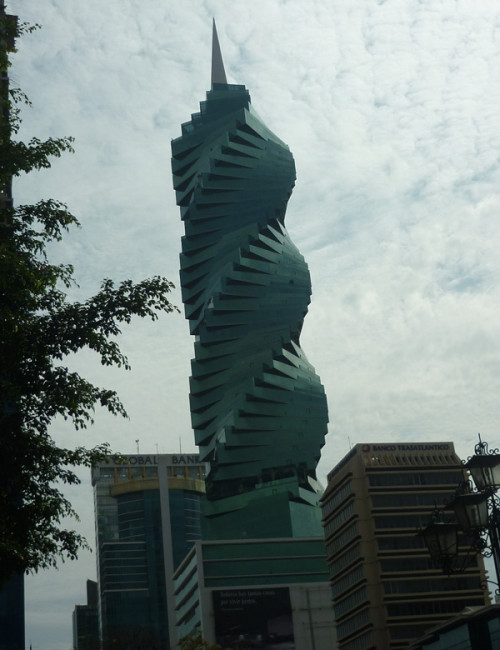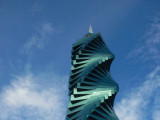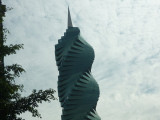Height rank
F&F Tower
Panama City
-
Metrics
You must be a CTBUH Member to view this resource.
Official Name
F&F Tower
Other Names
Revolution Tower
Type
Building
Status
Completed, 2011
Country
City
Function
A mixed-use tall building contains two or more functions (or uses), where each of the functions occupy a significant proportion of the tower's total space. Support areas such as car parks and mechanical plant space do not constitute mixed-use functions. Functions are denoted on CTBUH "Tallest Building" lists in descending order, e.g., "hotel/office" indicates hotel function above office function.
office
Structural Material
Both the main vertical/lateral structural elements and the floor spanning systems are constructed from steel. Note that a building of steel construction with a floor system of concrete planks or concrete slab on top of steel beams is still considered a “steel” structure as the concrete elements are not acting as the primary structure.
Reinforced Concrete
Both the main vertical/lateral structural elements and the floor spanning systems are constructed from concrete which has been cast in place and utilizes steel reinforcement bars.
Precast Concrete
Both the main vertical/lateral structural elements and the floor spanning system are constructed from steel reinforced concrete which has been precast as individual components and assembled together on-site.
Mixed-Structure
Utilizes distinct systems (e.g. steel, concrete, timber), one on top of the other. For example, a steel/concrete indicates a steel structural system located on top of a concrete structural system, with the opposite true of concrete/steel.
Composite
A combination of materials (e.g. steel, concrete, timber) are used together in the main structural elements. Examples include buildings which utilize: steel columns with a floor system of reinforced concrete beams; a steel frame system with a concrete core; concrete-encased steel columns; concrete-filled steel tubes; etc. Where known, the CTBUH database breaks out the materials used in a composite building’s core, columns, and floor spanning separately.
concrete
Height
232.7 m / 763 ft
Floors Above Ground
53
Floors Below Ground
4
# of Parking Spaces
769
# of Elevators
5
Top Elevator Speed
3 m/s
Tower GFA
60,753 m² / 653,940 ft²
-
By function
You must be a CTBUH Member to view this resource.
-
By material
You must be a CTBUH Member to view this resource.
Proposed
Construction Start
Completed
You must be a CTBUH Member to view this resource.
Owner/Developer
F&F Properties
Architect
Usually involved in the front end design, with a "typical" condition being that of a leadership role through either Schematic Design or Design Development, and then a monitoring role through the CD and CA phases.
Pinzon Lozano & Asociados Arquitectos
Usually takes on the balance of the architectural effort not executed by the "Design Architect," typically responsible for the construction documents, conforming to local codes, etc. May often be referred to as "Executive," "Associate," or "Local" Architect, however, for consistency CTBUH uses the term "Architect of Record" exclusively.
Luis Garcia Ingenieros
MEP Engineer
The Design Engineer is usually involved in the front end design, typically taking the leadership role in the Schematic Design and Design Development, and then a monitoring role through the CD and CA phases.
Ingenieria Atlantico
Main Contractor
The main contractor is the supervisory contractor of all construction work on a project, management of sub-contractors and vendors, etc. May be referred to as "Construction Manager," however, for consistency CTBUH uses the term "Main Contractor" exclusively.
The main contractor is the supervisory contractor of all construction work on a project, management of sub-contractors and vendors, etc. May be referred to as "Construction Manager," however, for consistency CTBUH uses the term "Main Contractor" exclusively.
Cocige
CTBUH Initiatives
Twisting Tall Buildings
18 August 2016 - CTBUH Research
About F&F Tower
The initial concept for the F&F tower, originally known as Revolution Tower, was a purely theoretical idea based on rotating geometry and a prism. This experiment was undertaken in the architect’s studio, and was observed by the prospective client who wished to appropriate the design for their own office tower. Hoping to create a trademark building, the client and design team worked with the original concept to come up with a feasible and unique design. The tower has a concrete structure, allowing each floor to rotate nine degrees from the floor below to create four small balconies for each office floor.
Located on a relatively small site (2,000 square meters) on a prominent commercial street in the city’s well-known banking district, the designers had to address many issues in their process to ensure the building’s iconic status and success. With a strict budget of US$50 million, the site’s set-backs as well as an adjacent gas station with underground wells were overcome to produce the distinctive tower.
Subscribe below to receive periodic updates from CTBUH on the latest Tall Building and Urban news and CTBUH initiatives, including our monthly newsletter. Fields with a red asterisk (*) next to them are required.
View our privacy policy




